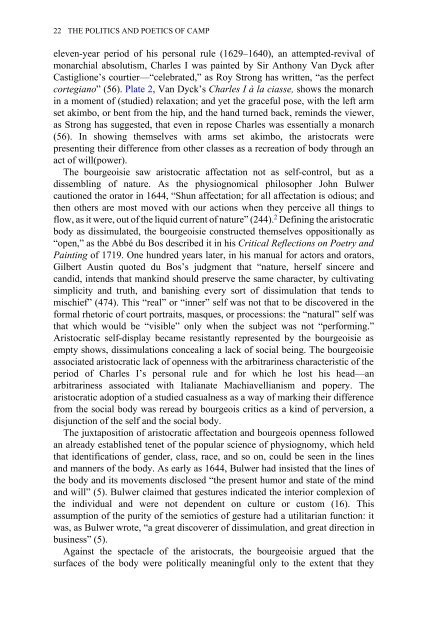Edited by Moe Meyer - Get a Free Blog
Edited by Moe Meyer - Get a Free Blog
Edited by Moe Meyer - Get a Free Blog
Create successful ePaper yourself
Turn your PDF publications into a flip-book with our unique Google optimized e-Paper software.
22 THE POLITICS AND POETICS OF CAMP<br />
eleven-year period of his personal rule (1629–1640), an attempted-revival of<br />
monarchial absolutism, Charles I was painted <strong>by</strong> Sir Anthony Van Dyck after<br />
Castiglione’s courtier—“celebrated,” as Roy Strong has written, “as the perfect<br />
cortegiano” (56). Plate 2, Van Dyck’s Charles I à la ciasse, shows the monarch<br />
in a moment of (studied) relaxation; and yet the graceful pose, with the left arm<br />
set akimbo, or bent from the hip, and the hand turned back, reminds the viewer,<br />
as Strong has suggested, that even in repose Charles was essentially a monarch<br />
(56). In showing themselves with arms set akimbo, the aristocrats were<br />
presenting their difference from other classes as a recreation of body through an<br />
act of will(power).<br />
The bourgeoisie saw aristocratic affectation not as self-control, but as a<br />
dissembling of nature. As the physiognomical philosopher John Bulwer<br />
cautioned the orator in 1644, “Shun affectation; for all affectation is odious; and<br />
then others are most moved with our actions when they perceive all things to<br />
flow, as it were, out of the liquid current of nature” (244). 2 Defining the aristocratic<br />
body as dissimulated, the bourgeoisie constructed themselves oppositionally as<br />
“open,” as the Abbé du Bos described it in his Critical Reflections on Poetry and<br />
Painting of 1719. One hundred years later, in his manual for actors and orators,<br />
Gilbert Austin quoted du Bos’s judgment that “nature, herself sincere and<br />
candid, intends that mankind should preserve the same character, <strong>by</strong> cultivating<br />
simplicity and truth, and banishing every sort of dissimulation that tends to<br />
mischief” (474). This “real” or “inner” self was not that to be discovered in the<br />
formal rhetoric of court portraits, masques, or processions: the “natural” self was<br />
that which would be “visible” only when the subject was not “performing.”<br />
Aristocratic self-display became resistantly represented <strong>by</strong> the bourgeoisie as<br />
empty shows, dissimulations concealing a lack of social being. The bourgeoisie<br />
associated aristocratic lack of openness with the arbitrariness characteristic of the<br />
period of Charles I’s personal rule and for which he lost his head—an<br />
arbitrariness associated with Italianate Machiavellianism and popery. The<br />
aristocratic adoption of a studied casualness as a way of marking their difference<br />
from the social body was reread <strong>by</strong> bourgeois critics as a kind of perversion, a<br />
disjunction of the self and the social body.<br />
The juxtaposition of aristocratic affectation and bourgeois openness followed<br />
an already established tenet of the popular science of physiognomy, which held<br />
that identifications of gender, class, race, and so on, could be seen in the lines<br />
and manners of the body. As early as 1644, Bulwer had insisted that the lines of<br />
the body and its movements disclosed “the present humor and state of the mind<br />
and will” (5). Bulwer claimed that gestures indicated the interior complexion of<br />
the individual and were not dependent on culture or custom (16). This<br />
assumption of the purity of the semiotics of gesture had a utilitarian function: it<br />
was, as Bulwer wrote, “a great discoverer of dissimulation, and great direction in<br />
business” (5).<br />
Against the spectacle of the aristocrats, the bourgeoisie argued that the<br />
surfaces of the body were politically meaningful only to the extent that they


